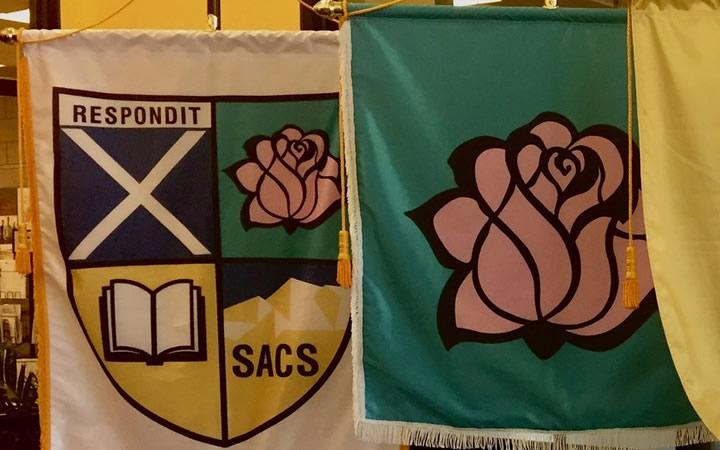Photo from www.standrewut.org
When Patrick Jefferies became principal at St. Andrew Catholic School outside of Salt Lake City, Utah, he made a commitment to foster a hospitable school environment for all who set foot inside the school, whether they be students, teachers, staff members, parents or visitors. One of Patrick's first steps was to attend ACE's 2015 Latino Enrollment Institute, a program that seeks to transform Catholic schools with open seats, favorable demographic potential, and motivated individuals by teaching them how to attract and serve Latino students more effectively.
 Patrick spent a week at the LEI Conference, offered over the summer on Notre Dame's campus. In just a week's time, he learned that some of the most effective means of fostering positive school culture were actually quite small in nature. In building the kind of school environment espoused by the Latino Enrollment Institute, Patrick implemented two subtle changes at St. Andrew—a daily handshake and a new school crest that included a rose. These two seemingly simple things brought about profound change at a rate that even Patrick could not have predicted.
Patrick spent a week at the LEI Conference, offered over the summer on Notre Dame's campus. In just a week's time, he learned that some of the most effective means of fostering positive school culture were actually quite small in nature. In building the kind of school environment espoused by the Latino Enrollment Institute, Patrick implemented two subtle changes at St. Andrew—a daily handshake and a new school crest that included a rose. These two seemingly simple things brought about profound change at a rate that even Patrick could not have predicted.
On his first day at St. Andrew, Patrick spent the morning shaking hands with everyone who entered the building in an effort to meet the parents, teachers, staff and students. This welcoming handshake soon became a daily ritual as Patrick returned to the same spot each morning, hand outstretched. With every handshake, he knew better the names and faces of those comprising his school community. Patrick's daily handshakes resonated with the families of St. Andrew in ways far deeper than he had initially imagined. Personal greetings for Salt Lake City's Latino population touch at the core of their cultural ethos, and so Patrick's handshakes—wordless as they were—said to all who entered St. Andrew, "Welcome home." Today, Patrick knows everyone who enters his school building. What began as a simple gesture of welcome has come to symbolize the deep connectedness between and among the community of St. Andrew.
"... he made a commitment to foster a hospitable school environment for all"
Patrick's LEI-rooted work took another form as well—one that capitalized on yet another lesson he internalized at the LEI conference. He had learned that using religious iconography is a powerful way to speak across the traditions and cultures of those within the school community. Bearing this in mind, Patrick's second minor change was creating a new crest for St. Andrew. In the upper right-hand corner of this shield is the rose, a traditional symbol for Mary, and one that evokes her apparitions to St. Juan Diego in Guadalupe in the late fifteenth century. Patrick purposely selected the rose and the turquoise background of the crest resembling Juan Diego's tilma, which bore Mary's image, because of their importance to Latinos. The inclusion of these details—coupled with the placement of an icon of Our Lady of Guadalupe in every classroom throughout the school—signaled an openness to and awareness of Latino culture that rests at the very heart of the parents and children of St. Andrew Catholic School. Knowing the inseparability of culture from language, Patrick also saw the power in bringing ACE's English as a New Language Program to the Salt Lake City diocese, helping to train teachers in the best practice of working with culturally and linguistically diverse students.
 These actions have transformed the community of St. Andrew. When Patrick took the job as principal in 2014, St. Andrew had a total enrollment of 156 students, 33 of whom were Latinos. After Patrick attended the LEI conference in 2015, those numbers grew to 201 total students and 58 Latinos. This year, St. Andrew began the year with 85 Latino students, which represents an increase of nearly 160% from when he began in 2014. Patrick attributes this growth to "paying attention to the details" and to the welcoming atmosphere in the school.
These actions have transformed the community of St. Andrew. When Patrick took the job as principal in 2014, St. Andrew had a total enrollment of 156 students, 33 of whom were Latinos. After Patrick attended the LEI conference in 2015, those numbers grew to 201 total students and 58 Latinos. This year, St. Andrew began the year with 85 Latino students, which represents an increase of nearly 160% from when he began in 2014. Patrick attributes this growth to "paying attention to the details" and to the welcoming atmosphere in the school.
Patrick continues to find ways to build a school that welcomes all people, not just one demographic or socioeconomic group. While his recent efforts have focused on increasing Latino enrollment, he works to make St. Andrew a place that all can call "home." The success that Patrick has experienced at St. Andrew is precisely the intended outcome of participating in the LEI. The LEI helped Patrick to implement acts of explicit and visible hospitality so his school could be a place where families feel "at home" in their quest to grow in knowledge, wisdom, and faith.
 Alliance for Catholic Education
Alliance for Catholic Education
